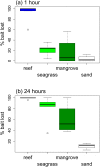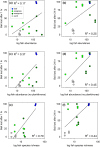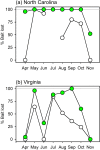Squidpops: A Simple Tool to Crowdsource a Global Map of Marine Predation Intensity
- PMID: 26599815
- PMCID: PMC4657994
- DOI: 10.1371/journal.pone.0142994
Squidpops: A Simple Tool to Crowdsource a Global Map of Marine Predation Intensity
Abstract
We present a simple, standardized assay, the squidpop, for measuring the relative feeding intensity of generalist predators in aquatic systems. The assay consists of a 1.3-cm diameter disk of dried squid mantle tethered to a rod, which is either inserted in the sediment in soft-bottom habitats or secured to existing structure. Each replicate squidpop is scored as present or absent after 1 and 24 hours, and the data for analysis are proportions of replicate units consumed at each time. Tests in several habitats of the temperate southeastern USA (Virginia and North Carolina) and tropical Central America (Belize) confirmed the assay's utility for measuring variation in predation intensity among habitats, among seasons, and along environmental gradients. In Belize, predation intensity varied strongly among habitats, with reef > seagrass = mangrove > unvegetated bare sand. Quantitative visual surveys confirmed that assayed feeding intensity increased with abundance and species richness of fishes across sites, with fish abundance and richness explaining up to 45% and 70% of the variation in bait loss respectively. In the southeastern USA, predation intensity varied seasonally, being highest during summer and declining in late autumn. Deployments in marsh habitats generally revealed a decline in mean predation intensity from fully marine to tidal freshwater sites. The simplicity, economy, and standardization of the squidpop assay should facilitate engagement of scientists and citizens alike, with the goal of constructing high-resolution maps of how top-down control varies through space and time in aquatic ecosystems, and addressing a broad array of long-standing hypotheses in macro- and community ecology.
Conflict of interest statement
Figures







References
-
- Elser J, Bracken M, Cleland E, Gruner D, Harpole W, Hillebrand H, et al. (2007) Global analysis of nitrogen and phosphorus limitation of primary producers in freshwater, marine and terrestrial ecosystems. Ecol Letters 10: 1135–1142. - PubMed
-
- Field C, Behrenfeld M, Randerson J, Falkowski P (1998) Primary production of the biosphere: integrating terrestrial and oceanic components. Science 281: 237–240. - PubMed
-
- Vitousek PM, Howarth RW (1991) Nitrogen limitation on land and in the sea: how can it occur? Biogeochemistry 13: 87–115.
-
- Running SW, Nemani RR, Heinsch FA (2004) A continuous satellite-derived measure of global terrestrial primary production. BioScience 54: 547–560.
Publication types
MeSH terms
LinkOut - more resources
Full Text Sources
Other Literature Sources

